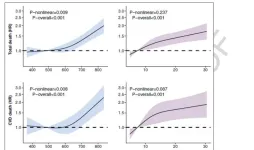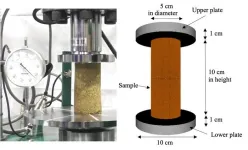(Press-News.org) Based on decades-long observations of centenarians, author Dan Buettner (Blue Zones) conjectures that people live longer when they get up and move around after sitting for twenty minutes. Now, a rigorous new study published in the Journal of the American Heart Association (JAHA) has data showing that older women who sat for 11.7 hours or more per day increased their risk of death by 30 percent, regardless of whether they exercised vigorously.
Study co-author Steve Nguyen, Ph.D., M.P.H., a postdoctoral fellow at the University of California San Diego Herbert Wertheim School of Public Health and Human Longevity Science, examined measurements of sitting and daily activity collected from hip devices worn for up to seven days by 6,489 women, aged 63 to 99, who were followed for eight years for mortality outcomes. This data was collected in a study led by Andrea LaCroix, Ph.D., M.P.H., Distinguished Professor at the Herbert Wertheim School of Public Health, as part of a long-term national project known as the Women’s Health Initiative (WHI), which began in 1991 and is ongoing.
Nguyen’s paper is the first to apply a novel and validated machine-learned algorithm called CHAP to examine total sitting time and length of sitting bouts in relation to the risk of death. “Sedentary behavior is defined as any waking behavior involving sitting or reclining with low energy expenditure,” explains Nguyen. “Previous techniques for calculating sedentary behavior used cut points that identified low or absent movement. The CHAP algorithm was developed using machine-learning, a type of artificial intelligence, that enhanced its ability to accurately distinguish between standing and sitting.” Fine-tuning “sitting” enabled Nguyen to parse total sitting time and usual sitting bout durations.
Sedentary behavior is a health risk because it reduces muscle contractions, blood flow and glucose metabolism. “When you're sitting, the blood flow throughout your body slows down, decreasing glucose uptake. Your muscles aren't contracting as much, so anything that requires oxygen consumption to move the muscles diminishes, and your pulse rate is low,” said LaCroix.
Unfortunately, exercise cannot undo these negative effects. According to the study, whether women participated in low or high amounts of moderate-to-vigorous intensity physical activity, they showed the same heightened risk if they sat for long hours.
“If I take a brisk long walk for an hour but sit the rest of the day, I'm still accruing all the negative effects on my metabolism,” said LaCroix.
Based on the research, LaCroix makes the following recommendation: “The risk starts climbing when you’re sitting about 11 hours per day, combined with the longer you sit in a single session. For example, sitting more than 30 minutes at a time is associated with higher risk than sitting only 10 minutes at a time. Most people aren't going to get up six times an hour, but maybe people could get up once an hour, or every 20 minutes or so. They don't have to go anywhere, they can just stand for a little while.”
However, Nguyen points out that not all sitting is the same. “Looking beyond conditions like cardiovascular disease, we start thinking about cognitive outcomes, including dementia,” he said. “There are cognitively stimulating activities that can result in sedentary behavior, like sitting while studying a new language. Is sedentary behavior in that context overall bad for a person? I think it's hard to say.” Nguyen has recently received a National Institute of General Medical Sciences K99 award for 12 months of mentored research to look at protein signatures of physical activity and how they relate to dementia.
LaCroix is sympathetic to the challenges of modifying sedentary behavior, but she knows that the modifications are necessary, if not easy. “We've created this world in which it's so fascinating to sit and do things. You can be engrossed by TV or scroll on your Instagram for hours. But sitting all the time isn't the way we were meant to be as humans, and we could reverse all of that culturally just by not being so attracted to all the things that we do while sitting.”
Co-authors on the study include John Bellettiere, Blake Anuskiewicz and Loki Natarajan at UC San Diego, Chongzhi Di at Fred Hutchinson Cancer Center, Jordan Carlson at Children’s Mercy Kansas City and Michael J. LaMonte at University at Buffalo.
This study was funded, in part, by the National Institutes of Health (grants P01 AG052352, R01 HL105065, 75N92021D00001, 75N92021D00002, 75N92021D00003, 75N92021D00004, 75N92021D00005, 5T32AG058529‐03, R01DK114945) and the Tobacco-Related Disease Research Program
The authors declare no competing interests.
# # #
END
Sedentary behavior increases mortality risk
Sitting for long hours without breaks increases risk of death
2024-02-28
ELSE PRESS RELEASES FROM THIS DATE:
New approach may prevent deadly intestinal disease in preemies
2024-02-28
Scientists from Stanley Manne Children’s Research Institute at Ann & Robert H. Lurie Children’s Hospital of Chicago and colleagues found that an investigational protein replacement – recombinant human insulin-like growth factor 1 and its binding protein-3 (rhIGF-1/BP3) – protected neonatal mice from necrotizing enterocolitis (NEC), a deadly intestinal disease that often strikes extremely premature infants. Results were published in the journal Pediatric Research.
“Our preclinical evidence is encouraging and paves the way to a clinical trial of rhIGF-1/BP3 for prevention of NEC,” said senior author Isabelle De Plaen, MD, a scientist ...
Endocrine Society supports federal legislation protecting IVF access
2024-02-28
WASHINGTON—The Endocrine Society is calling for members of Congress to support federal legislation protecting access to in vitro fertilization (IVF).
The Access to Family Building Act (S.3612/H.R.7056), proposed by Sens. Tammy Duckworth (D-IL), Patty Murray (D-WA), and Rep. Susan Wild (D-PA), would ensure people can access safe, effective IVF and other assisted reproductive technologies to start or grow their families.
Families’ access to IVF services is being threatened by an Alabama State Supreme Court ruling that frozen embryos ...
World’s first metamaterial developed to enable real-time shape and property control
2024-02-28
Inspired by the remarkable adaptability observed in biological organisms like the octopus, a breakthrough has been achieved soft machines. A research team, led by Professor Jiyun Kim in the Department of Materials Science and Engineering at UNIST has successfully developed an encodable multifunctional material that can dynamically tune its shape and mechanical properties in real-time. This groundbreaking metamaterial surpasses the limitations of existing materials, opening up new possibilities for applications in robotics and other fields requiring adaptability.
Current soft machines lack the level of adaptability demonstrated by their ...
Pancreatic cancer lives on mucus
2024-02-28
Knowing exactly what’s inside a tumor can maximize our ability to fight cancer. But that knowledge doesn’t come easy. Tumors are clusters of constantly changing cancer cells. Some become common cancer variants. Others morph into deadlier, drug-resistant varieties. No one truly understands what governs this chaotic behavior.
Now, Cold Spring Harbor Laboratory (CSHL) Professor David Tuveson and his team have uncovered a mechanism involved in pancreatic cancer transformation—mucus. During the disease’s early stage, pancreatic cancer cells produce mucus. Additionally, these cells depend on the body’s regulators of mucus production. This new ...
Want fewer microplastics in your tap water? Try boiling it first
2024-02-28
Nano- and microplastics are seemingly everywhere — water, soil and the air. While many creative strategies have been attempted to get rid of these plastic bits, one unexpectedly effective solution for cleaning up drinking water, specifically, might be as simple as brewing a cup of tea or coffee. As reported in ACS’ Environmental Science & Technology Letters, boiling and filtering calcium-containing tap water could help remove nearly 90% of the nano- and microplastics present.
Contamination of water supplies with nano- and microplastics (NMPs), which can be as small as one thousandth of a millimeter ...
AGA announces 12-point plan to improve the care of all patients with inflammatory bowel disease (IBD)
2024-02-28
Bethesda, MD (Feb. 28, 2024) — Today, the American Gastroenterological Association (AGA) published a white paper on the future of inflammatory bowel disease (IBD) care in the United States. AGA highlights the current barriers to care and calls for collaboration among our healthcare community, insurers, pharmaceutical companies and legislators to improve and optimize care for the more than three million Americans living with IBD.
IBD is a complex disease that requires a vigilant and coordinated multidisciplinary approach. ...
Shedding light on the intricacies of numerical simulations of soil behavior
2024-02-28
A solid understanding of soil mechanics and behavior is one of the fundamental pillars of geotechnical engineering. The stability and resilience of many modern geotechnical structures, including building foundations, dams, bridges, and embankments, rely on appropriate modelling based on accurate measurements of soil properties.
Over the past few decades, unprecedented growth in computing power has turned numerical simulations of soil behavior into an attractive tool in geotechnical engineering. By representing soil as a set of interacting particles, numerical simulations can help researchers understand complex soil behavior under various conditions. Moreover, numerical ...
Promising pathways to simplified Alzheimer's diagnosis unveiled in groundbreaking study
2024-02-28
Washington D.C., Feb. 28, 2024- The Global Alzheimer’s Platform Foundation®, (GAP) is releasing the first results from the Bio-Hermes-001 Study. This study in over 1000 community-based participants from throughout the US compared the results of blood and digital biomarkers with brain amyloid PET scans or cerebrospinal fluid assays. The study revealed a strong correlation between several blood tests, particularly p-tau 217, with the presence of amyloid plaques in the brain, a diagnostic hallmark of Alzheimer’s disease (AD). This relationship was demonstrated across the entire study ...
Understanding genetic risk could save sight and predict multiple sclerosis earlier in young people
2024-02-28
Young people could be spared from going blind by a new genetic risk tool that could also help diagnose multiple sclerosis (MS) earlier, to start effective treatments.
Optic neuritis is a condition that affects people of all ages, but especially young adults, usually manifesting in blurred vision and sometimes pain when moving the eyes. Up to half of people affected in the UK eventually go on to develop MS – often many years later. Emerging evidence indicates that starting the very effective MS treatments earlier may improve long term health.
Optic neuritis occurs because of swelling in or around the optic nerve. For those with MS-related optic neuritis, the swelling subsides ...
Cannabis use linked to increase in heart attack and stroke risk
2024-02-28
Research Highlights:
An analysis of survey data for 430,000 adults in the U.S. found that using cannabis has a significant association with an increased risk of heart attack and stroke, independent of tobacco use, with higher odds among the adults with more frequent use (more days of use per month). The most common method of cannabis use was smoking, followed by eating or vaporizing it.
The increase in the combined risk of coronary heart disease, heart attack and stroke was similar to the risk among the subset of adults who had never used e-cigarettes but did use cannabis.
Embargoed until 4 a.m. CT/5 a.m. ET Wednesday, February ...
LAST 30 PRESS RELEASES:
Nanoplastics have diet-dependent impacts on digestive system health
Brain neuron death occurs throughout life and increases with age, a natural human protein drug may halt neuron death in Alzheimer’s disease
SPIE and CLP announce the recipients of the 2025 Advanced Photonics Young Innovator Award
Lessons from the Caldor Fire’s Christmas Valley ‘Miracle’
Ant societies rose by trading individual protection for collective power
Research reveals how ancient viral DNA shapes early embryonic development
A molecular gatekeeper that controls protein synthesis
New ‘cloaking device’ concept to shield sensitive tech from magnetic fields
Researchers show impact of mountain building and climate change on alpine biodiversity
Study models the transition from Neanderthals to modern humans in Europe
University of Phoenix College of Doctoral Studies releases white paper on AI-driven skilling to reduce burnout and restore worker autonomy
AIs fail at the game of visual “telephone”
The levers for a sustainable food system
Potential changes in US homelessness by ending federal support for housing first programs
Vulnerability of large language models to prompt injection when providing medical advice
Researchers develop new system for high-energy-density, long-life, multi-electron transfer bromine-based flow batteries
Ending federal support for housing first programs could increase U.S. homelessness by 5% in one year, new JAMA study finds
New research uncovers molecular ‘safety switch’ shielding cancers from immune attack
Bacteria resisting viral infection can still sink carbon to ocean floor
Younger biological age may increase depression risk in older women during COVID-19
Bharat Innovates 2026 National Basecamp Showcases India’s Most Promising Deep-Tech Ventures
Here’s what determines whether your income level rises or falls
SCIE indexation achievement: Celebrate with Space: Science & Technology
Children’s Hospital Colorado performs region’s first pediatric heart and liver dual organ transplant
Australian team discover why quantum computers have memory problems over time
What determines the fate of a T cell?
Candida auris: genetic process revealed which could be treatment target for deadly fungal disease
Groundbreaking discovery turns household plastic recycling into anti-cancer medication
Blocking a key inflammatory pathway improves liver structure and vascular function in cirrhosis, study finds
Continuous spread: Raccoon roundworm detected in nine European countries
[Press-News.org] Sedentary behavior increases mortality riskSitting for long hours without breaks increases risk of death





